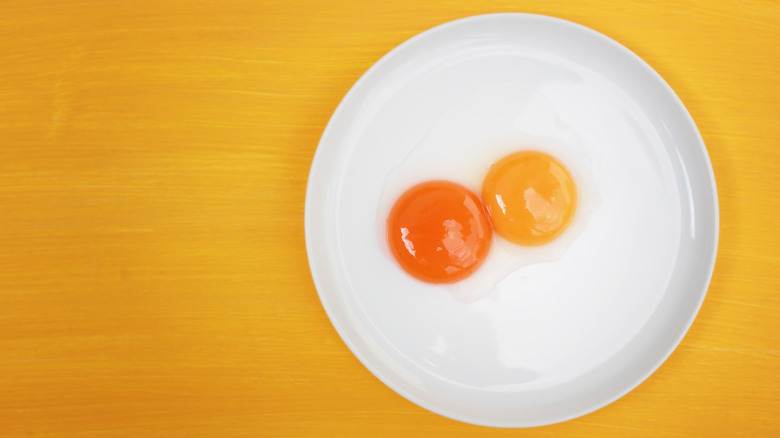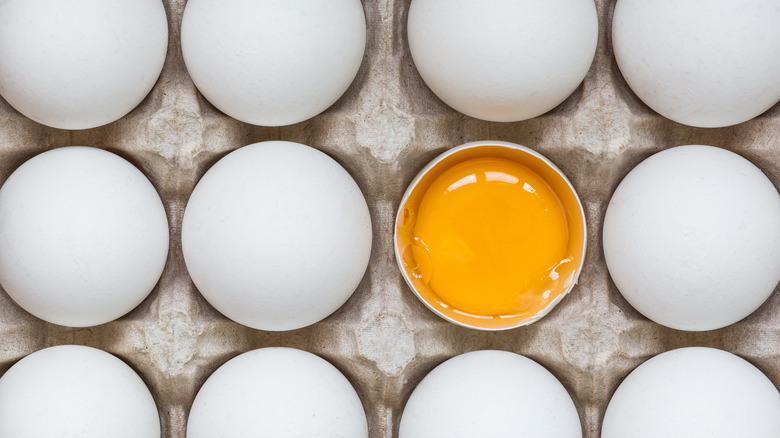Orange Egg Yolks Aren't Necessarily Better Than Yellow
Oh, how food opinions have shifted over the years. It seems the world has transitioned from an insistence on pale egg white omelets to an outright fascination with vivid orange, jammy egg yolks. This egg attitude adjustment can likely be attributed to evolving trends in nutritional science and the growing influence of the farm-to-table movement. In the mid-20th century, egg yolks were avoided by many for their cholesterol content, but in more recent years, eggs (yolk and all) have been fully embraced for their nutritional value and visual appeal.
This newfound love for eggs has further evolved into a broader curiosity about their origins and a discerning appetite for high-quality eggs. It's become a common belief among many that the presence of orange yolks indicates happier chickens and more nutritious eggs. However, the Harvard School of Public Health challenges this notion, claiming that yolk color alone does not significantly impact their nutritional profile. To fully understand the dynamics behind this, it's beneficial to delve into the origins of the color in egg yolks and learn how to identify an egg that truly is of high quality. Understanding these aspects can help you make more informed choices when you reach the egg aisle.
Where egg yolks get their color
The color of an egg yolk reflects the diet of the chicken that lays it. In the same way that eating too many beets can turn your leavings red or consuming an abundance of carrots can give your skin an orange hue, the color of the eggs varies based on what the chickens have eaten. Poultry specialists note that chickens in Tanzania often produce very pale egg yolks due to their diet of lightly pigmented sorghum; similarly many South American chickens fed a diet of red annatto seeds produce eggs with reddish-orange yolks.
The yellow and orange pigmentation commonly found in egg yolks is primarily due to plant pigments known as carotenoids, especially lutein and zeaxanthin. These pigments are present in chicken feed, which may include natural sources like marigolds and corn. While the presence of carotenoids, which Healthline shares is beneficial for immune health, they are present in essentially all eggs, and the color difference may account for only a small difference in the total amount they contain.
Additionally, feeds can contain various vegetables or additives specifically chosen to give yolks the bright yellow color many consumers prefer. To achieve the desired yolk color, many farmers use tools like the YolkFan. This tool helps them assess the color of their egg yolks and make adjustments to align with consumer preferences, which often favor darker, more orange-toned yolks.
What to look for when buying eggs
When shopping for eggs, consider their labels over their yolk color. Understanding egg grades is a good starting point. The USDA bases egg grades on the quality of the eggshell and the condition of the egg white and yolk. Grade AA eggs have thick, firm whites and round, high yolks, so this is typically the freshest and highest-quality option. Grade A eggs are similar but slightly less firm. Grade B eggs are lower in quality and are typically used for processed foods and liquid eggs.
After grade, the chicken's diet (usually indicated on the carton's label) is another place to assess quality. The organic label is reserved for eggs from chickens fed an organic diet, and "vegetarian-fed" means their diet didn't include animal byproducts. Omega-3 enriched eggs, come from chickens with diets rich in omega-3 sources, such as flaxseed. Terms like "hormone-free" are more for marketing, as hormones are not allowed in poultry in the U.S. Also, consider the living conditions of the chickens, which may also be noted on the package. Labels like "cage-free," "free-range," and 'pasture-raised' indicate the level of outdoor access for chickens, with pasture-raised providing the most freedom.
Ultimately, don't get too hung up on the egg yolk's color. The real good stuff, like vitamins and minerals, is in the yolk, no matter what shade it is. So go ahead and enjoy the whole egg — you're getting all the nutrients either way.


